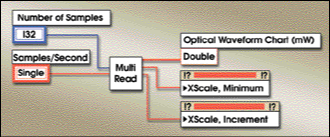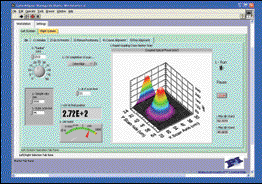Scott Jordan, PI; Monica Bar-Sever, Small Planet Photonics; and Brian Betts, National Instruments Inc.
It is not uncommon for scanning, alignment and spectroscopy applications to involve piezoelectric nanopositioning stages. One typical requirement, measurement of optical signals that vary rapidly as a function of position or time, isn't as simple as it sounds, though. Throughput problems are fairly common because optical power metrology technology has not kept up with advances in positioning technology. The specific culprits include long latencies, slow sampling, limited bandwidth, leisurely autoranging and poor communications speeds.
In the past, such limitations required processes to be performed in a point-wise, step-by-step fashion with dwells to accommodate the optical power meter. Even when continuous scanning was possible, slow scan speeds were necessary for these reasons. Although meters theoretically could be sampled at extremely high rates, their slow autoranging capabilities and limited analog bandwidth -- typically on the order of about a few dozen hertz -- set a barrier to faster scanning, tuning and alignment.
Finding a solution to this problem has been difficult because it requires not only advances in the power meter architecture itself, but also in its interface to the positioning equipment. To understand the reason, it helps to examine why the interface requirements are important in nanopositioning.
Analog interfacing
Analog interfacing remains the most common and fastest way to command piezoelectric motion systems. A key advantage of this approach is precise timing of analog input and output signals maintained by the data acquisition device, independent of the rest of the PC. The popularity of analog input/output continues to increase with the popularity and functionality of data acquisition devices for PCs, and programming environments such as LabView from National Instruments Inc. in Austin, Texas, that allow rapid construction of automated applications that can include arbitrary waveform generation and "virtual oscilloscope" data acquisition.
Even the most affordable multifunction data acquisition devices can acquire and process hundreds of thousands of data points per second. Using software environments like LabView, data can be sent directly into the PC's memory or spooled to disk or across a network at these rates. Typical devices provide either 12- or 16-bit resolution. A 12-bit device with a range of 0 to 10 V can measure input voltage changes as low as 2.4 mV. The 16-bit version can resolve to as little as 0.15 mV.
The analog outputs of a multifunction data acquisition device determine the resolution that is possible with the nanopositioning stage. For example, the resolution quoted for piezoelectric devices, which represents the drive amplifier's noise level, can be less than 1 nm, but the minimum incremental motion often is limited by the bit resolution of the analog position-command signal. For a stage with 25-µm travel that uses a standard 0 to 10-V analog interface, the 12-bit output of a multifunction device would provide positional resolution of 6.1 nm. The 16-bit device would provide 0.4 nm.
Besides their precision, piezoelectric actuators can achieve 10,000 g acceleration. Putting this fact together with the previous two paragraphs, it is evident that precision nanopositioning applications can play off the high data throughput that is possible with multifunction data acquisition devices if the power meter technology can keep up.
Engineers at Small Planet Photonics in Irvine, Calif., believe that the solution to this problem lies in the use of what they call a parallel analog interface. The patent-pending interface, which is used on the firm's small-footprint PM series power meters, capitalizes on the high throughput and accurate timing of today's data acquisition devices. The use of two analog outputs -- e.g., normalized value and decade range 1 to 0.1 mW -- allows a card to accurately digitize a large volume of sensor measurements in real time with linear scaling. The alternative logarithmic scaling technique, which is somewhat common with older power meter architectures, coarsens resolution by spreading the finite number of data bits over several decades of range.

Figure 1. The LabView driver set supports scalar (single reading) and array (timed data) formats. Multichannel and motion-synchronized nonstop scans are possible.
For throughput-intensive applications, the multifunction data acquisition device can tightly time the power reading retrieved to other I/O's (Figure 1). Time stamping and a real-time status indicator help validate data. The meter, which features traceability to the National Institute of Standards and Technology (NIST), supports this fast interface methodology with a 10-kHz analog bandwidth and 70-µs autoranging speed, as well as six decades of autoranging and a large sensitive area.
To build on the integration capabilities of the parallel analog interface, engineers at PI (Physik Instrumente) USA in Auburn, Mass., developed a library of modular LabView subroutines (Figure 2). These integrate motion-waveform generation with synchronous optical power data acquisition and NIST-traceable accuracy into a plug-and-play format. Sampling rates can exceed 100,000 samples per second, with each data point tightly correlated to stage position. Time stamping also allows correlating information with other data taken concurrently but independently. The library set natively supports applications that must synchronize real-time continuous-motion pattern generation with one or more optical signals.

Figure 2. The software tools used with Small Planet Photonics power meters help synchronize device integration with high-speed nanopositioning in complex applications such as this input screen for a custom multichannel waveguide I/O alignment workstation.
The bottom line is that a system can perform a full-field optical scan of an X-Y piezoelectric nanopositioning stage in under 400 ms. This is two to three orders of magnitude faster than was previously possible for comparable data sets using pointwise acquisition.
As a result of the high-speed data communications that are now possible, end users can begin to use advanced sampling strategies that previously were impossible. Examples include pretrigger analysis, synchronous or pseudosynchronous sampling, stream-to-disk sampling and Web-enabled deterministic metrology coupled with synchronous motion. The interface technology also allows integrating power meters with digital piezoelectric motion system controls.